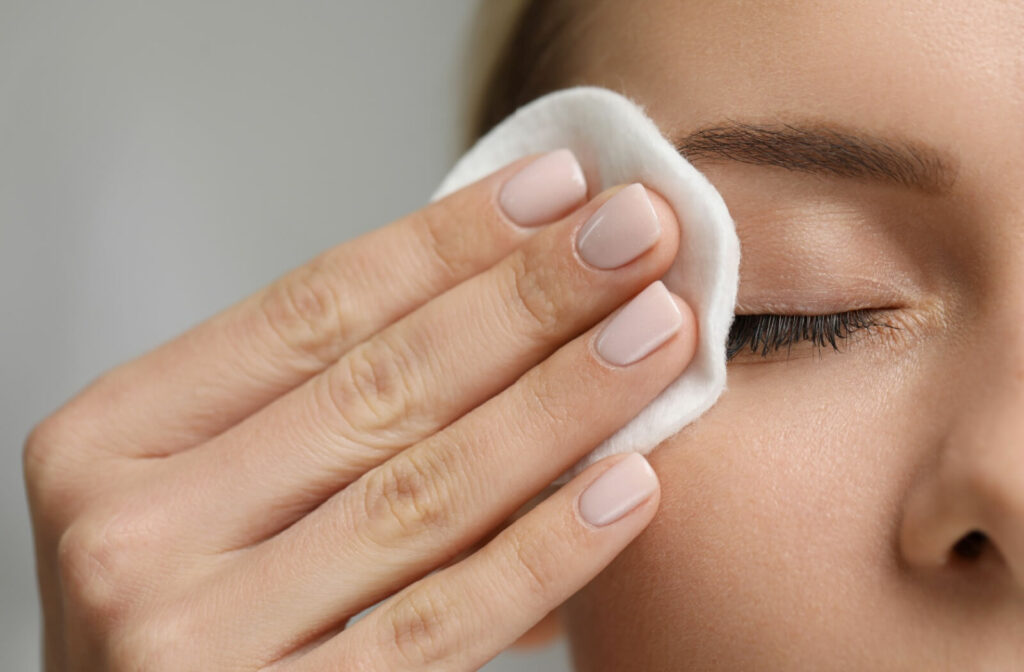Dry, irritated eyes and blurry vision are symptoms of dry eye syndrome, a common condition that frequently goes undiagnosed and untreated. For some, this is caused by meibomian gland dysfunction (MGD), which affects the glands in the eyelids.
Fortunately, a comprehensive eye exam can easily diagnose MGD. Your eye doctor can suggest a treatment plan, combining home treatments and prescription medications that will work best for your eyes.
What Is Meibomian Gland Dysfunction?
Meibomian Gland Dysfunction, or MGD, occurs when the meibomian glands in your eyelids don’t secrete enough oil or the oil is of poor quality. These glands play a crucial role in maintaining the health of your eyes by producing the oily layer of your tear film, which prevents tears from evaporating too quickly.
MGD can sometimes cause mild discomfort or pain. Common symptoms of MGD include dryness, redness, a gritty sensation, and blurry vision. Some people also experience crusting around the eyelids or an increased sensitivity to light.
Several factors can contribute to MGD, including age, hormonal changes, and certain medications. Environmental factors like prolonged screen time and poor blinking habits can also exacerbate the condition.
How Is MGD Diagnosed?
Diagnosing eye conditions starts with a comprehensive eye exam. Your eye care provider will ask questions about your symptoms, eye health, medical history, and lifestyle habits. Discuss your dry eye symptoms and lifestyle with your optometrist to receive personalized care and guidance.
Your optometrist will examine multiple aspects of your vision and your eye health, including an examination of your eye tissues, eyelids, and surrounding areas. They’ll also use various tools to conduct an internal eye examination to help detect various eye diseases and conditions.
How to Treat Meibomian Gland Dysfunction
There are several easy ways to treat MGD at home, though the most effective method is regularly applying a heating pad, such as a Bruder mask, to your eyes. This provides consistent heat for 5-10 minutes, which helps melt the meibomian glands’ oils, making them flow more easily and preventing blockages. You can heat the mask in the microwave for about 20 seconds and place it over your closed eyelids daily for optimal results.

It’s also beneficial to maintain good eyelid hygiene. Use a gentle cleanser to clean your eyelids regularly, removing any debris or crust that might block the glands. There are also over-the-counter eyelid wipes and sprays specifically designed for this purpose.
However, at-home treatments are more effective when combined with medication prescribed by your optometrist, which can help manage symptoms. Certain ointments or eyedrops can reduce inflammation, and some medications can improve the quality of the oil the glands produce.
How Long Does It Take to Treat Meibomian Gland Dysfunction?
Treating MGD is usually a long-term commitment. Some treatments, like warm compresses and eyelid hygiene, can offer quick relief. However, these are often temporary solutions and must be part of a consistent routine for long-term benefits. It can take several weeks to months to see significant improvement.
Consistency and commitment to your treatment plan help effectively manage your symptoms.
If your symptoms persist despite following a treatment plan, it’s essential to consult your eye care provider. They may need to adjust their treatment or explore alternative therapies. They may also suggest BlephEx and or IPL to promote better tear quality and reduce dry eye symptoms.
What Questions Should I Ask if I Think I Have MGD?
If you suspect you may have meibomian gland dysfunction, thoroughly discussing it with your eye care provider is important. Here are some key questions to consider asking during your appointment:
- What specific symptoms of MGD should I be aware of? Your eye doctor can help you understand the full range of symptoms.
- What tests will you perform to diagnose MGD? Ask about the diagnostic process and any specialized tests that your eye doctor deems necessary.
- What lifestyle changes can I make to help alleviate my symptoms? Get recommendations on how to adjust your daily habits and your nutrition, to support eye health.
- What treatment options are available, and how effective are they? Understanding the various treatments, including their risks and benefits, can help you make informed decisions.
- How long will it take to see improvement, and how will we measure progress? Knowing what to expect can provide reassurance during the treatment process.
- When should I schedule follow-up appointments, and what indicators suggest I need to return sooner? Establishing a timeline for follow-up care will help you manage your treatment effectively.
Asking these questions can empower you with the knowledge necessary to take proactive steps toward managing your eye health.
Try Dry Eye Therapy Today
At Eye Q Optometry, we know that meibomian gland dysfunction is a common yet often overlooked cause of dry eye disease. Contact us today to see how dry eye treatments can help you relieve persistent dry eye symptoms.










